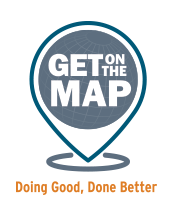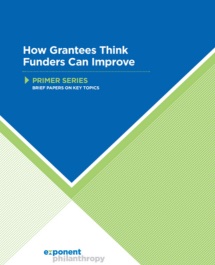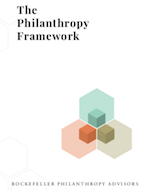Publication Date: November, 2015
This weekly conference call series welcomed New Jersey-based grantmakers along with national funders and provided an opportunity for grantmakers to hear from a wide range of experts in the field of disaster philanthropy. Series 1 started on November 5, 2012, one week after Sandy struck New Jersey, and continued through March 25, 2013. Series 2 started on September 9, 2013 and concluded on November 4, 2013. The written compendium of the recordings is listed below.
Publication Date: November, 2015
This weekly conference call series welcomed New Jersey-based grantmakers along with national funders and provided an opportunity for grantmakers to hear from a wide range of experts in the field of disaster philanthropy. This series started on November 5, 2012, one week after Sandy struck New Jersey, and continued through March 25, 2013. The written summaries of each recording are listed below.
... elected the new class of trustees, and heard reports about the state of the organization. After lunch and time to ... they operate. During the virtual workshop, members learned about the changemaker experience, how it affects the ...
... who have the expertise you need. You can learn more about the platform by watching this short, 3 minute video . ... with ValuesAdvisor Co-Founder Kate Simpson, you will learn about how the platform can be used to further your mission ...
... leaders in conversation with disability advocates about how we can move toward a more equitable, inclusive ... share with anyone you know that's interested in learning about disability inclusion, rights, and justice. CART will be ...
... Refugees, funders will learn from experts on the ground about their efforts to champion universal representation and ... webinar, funders will learn from experts on the ground about their efforts to champion universal representation and ...
Publication Date: August, 2013
Philanthropic organizations of all shapes and sizes are well positioned to support Communities for a Lifetime (CfaL). This issue brief explores four roles for philanthropy in advancing CfaL work.
Publication Date: June, 2013
As older adults are increasingly choosing to age in place, cross-cutting issues are coming to the forefront – the quality of care received by disabled or chronically ill older adults in their own homes, and the quality of the jobs of the caregivers who provide this care.
In-home care is often provided by direct care workers – an over-arching term that captures a number of different occupations, but in general refers to caregivers who provide essential assistance with everyday tasks like bathing, dressing, and eating. Direct care workers play a huge role in maintaining the health and general well-being of their clients. And, due to the oncoming “silver tsunami” of older adults, direct care jobs are some of the fastest growing occupations in the entire economy.
Despite the size of the workforce and the important services that direct care workers provide, the workforce is faced with a number of challenges. These include extremely low pay, irregular hours, inadequate training, and high rates of employee turnover. There is a clear need for better employment practices and policy changes to improve the quality of direct care jobs, by raising pay and benefits, standardizing and increasing employee training, and creating career pathways that lead to higher paying jobs. These efforts, in turn, will help improve the quality of the care that older adults receive.
In this edition of What Funders Need to Know, Washington Regional Association of Grantmakers take a look at the state of the local direct care workforce today and the connections between quality jobs and quality care, and discuss five ways that funders can get involved.
... ahead. I'm reaching out once again to remind you about the CNJG Annual Meeting & Holiday Gathering - our ... through Leadership: Maximizing Philanthropic Impact , is about how we can use leadership to drive meaningful and ... reflection, and connection - an opportunity to think about where we've been and where we want to go next. Here's ...
Publication Date: January, 2011
It’s Jan. 1 and I am thinking about 2015, as many of us are. Thinking about plans, what must be accomplished, what new projects and ... to reach out to our organizations when they have questions about the sectors, as well as for information and assistance. ...
Share your giving data and Get on the Map!
Your data will power valuable resources for your organization and our region including access to the CNJG Foundation Funding Map and COVID-19 Funding Map on the powerful interactive searchable mapping platform, engineered by Candid.
How to share your data
 Export your grants data from your software system.
Export your grants data from your software system.
Most grants management software products have documented how to export the information.
If you don’t see your software provider on that list, download their eReporting template, an Excel spreadsheet, which you can use to complete the information they need.
Submit your data to Candid by emailing the completed template with your data in it to [email protected] and cc Craig Weinrich.
You can also follow the detailed instructions on this page.
Candid will make every effort to post your data to the map within 5 business days.
Get the answers to your Frequently Asked Questions including:
What information do I need to provide?
Why is it important to provide a grant description?
How is my grants data coded by Candid?
How frequently should I share my grants data?
How quickly will my information appear on my complimentary map?
Can I embed my complimentary map on my website?
What should I do if corrections need to be made to my data?
How will my grant information be used and shared?
How do I responsibly share sensitive grants data?
... 2020, we’re also pleased to ask demographic information about your board and staff within this survey. Even if you do ... complete the survey . While the survey is long – taking about 45 minutes to complete – it allows us to create a ... the survey in one sitting. If you have any questions about the survey, please contact Director of Member ...
... means too many voices go unheard. It means decisions about funding and services crucial to promoting thriving ... with our colleagues across the nation serious concern about this question. The question hasn’t been thoroughly ... or Theresa Jacks , CNJG Deputy Director, for information about the Council’s work on behalf of a fair and accurate ...
... attendees to NJAAF’s work and offer a frank conversation about economic barriers that making it difficult for ... and PAC account management team. Emily is passionate about building community and connecting supporters to causes they care about in deep, meaningful ways. Emily holds a Master’s in ...
Publication Date: January, 2024
... (FOMR) and links to additional resources to learn more about these topics. How Grantees Think Funders Can Improve ...
Publication Date: March, 2019
... Compact, its implicit or explicit agreement with society about the value it will create Operating Model, the approach ...
Publication Date: July, 2014
... Foundation Funding for U.S. Democracy, provides data about foundations and their democracy-related grantmaking in ...
... for seeking help took many forms. It wasn’t just about selling the city to businesses. It also meant ...
 Export your grants data from your software system.
Export your grants data from your software system.

